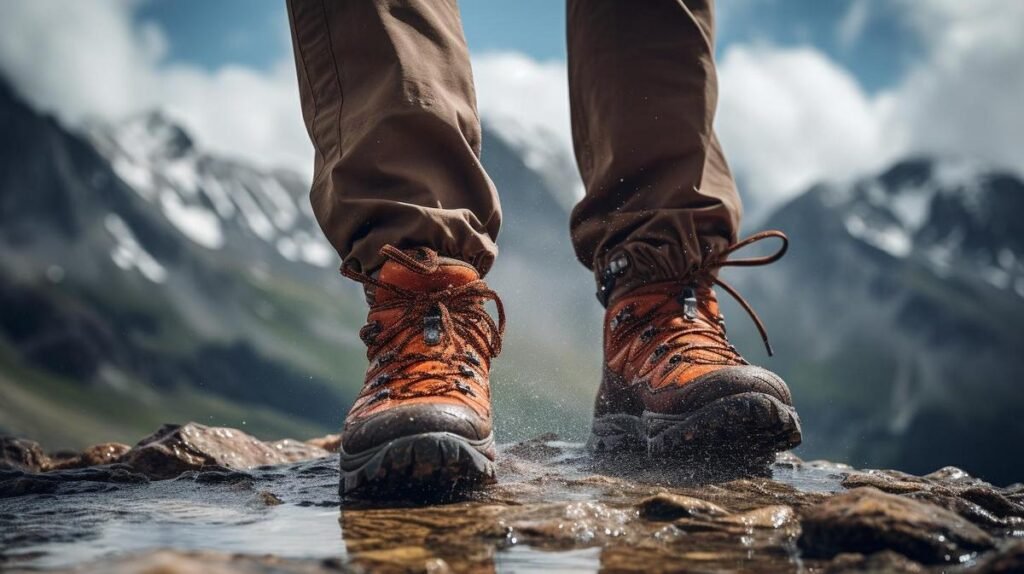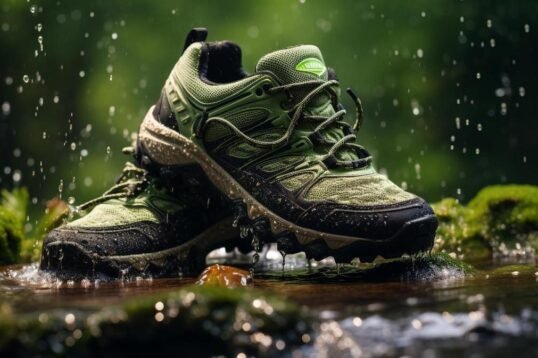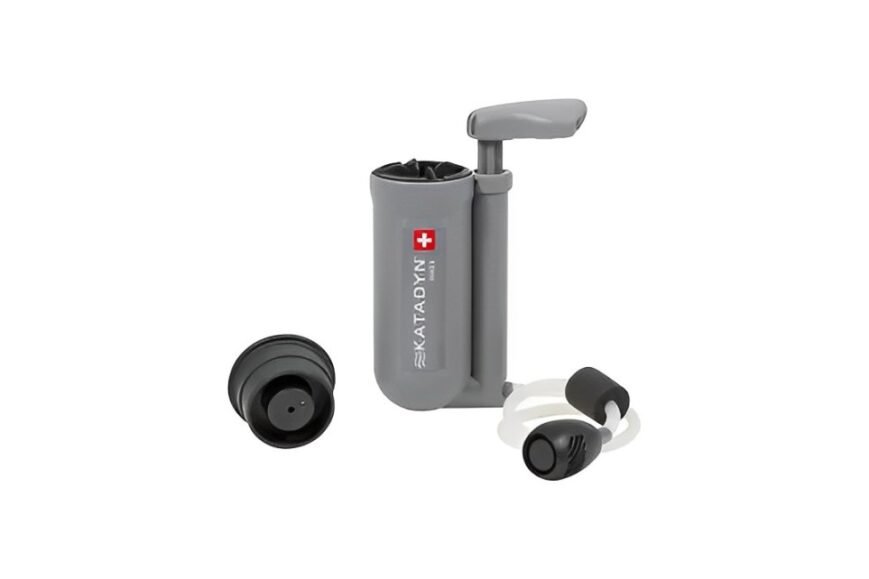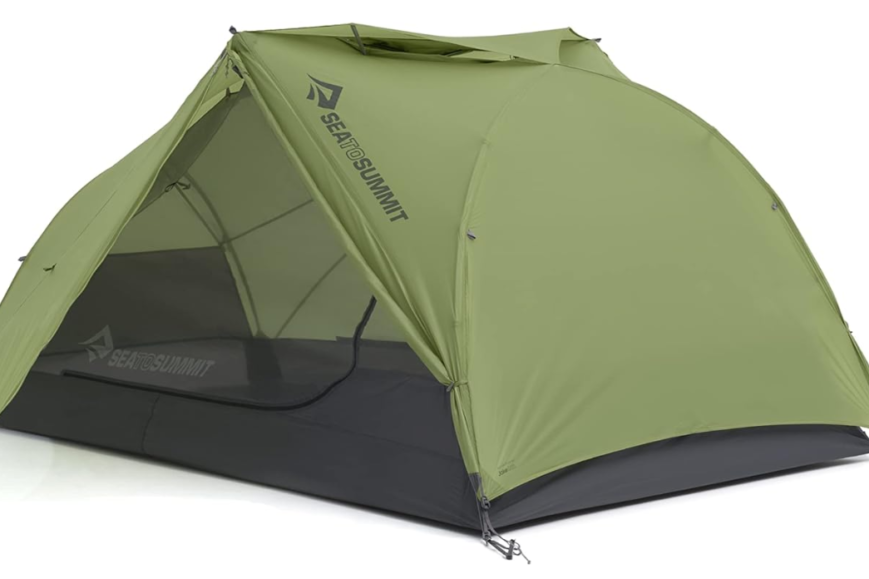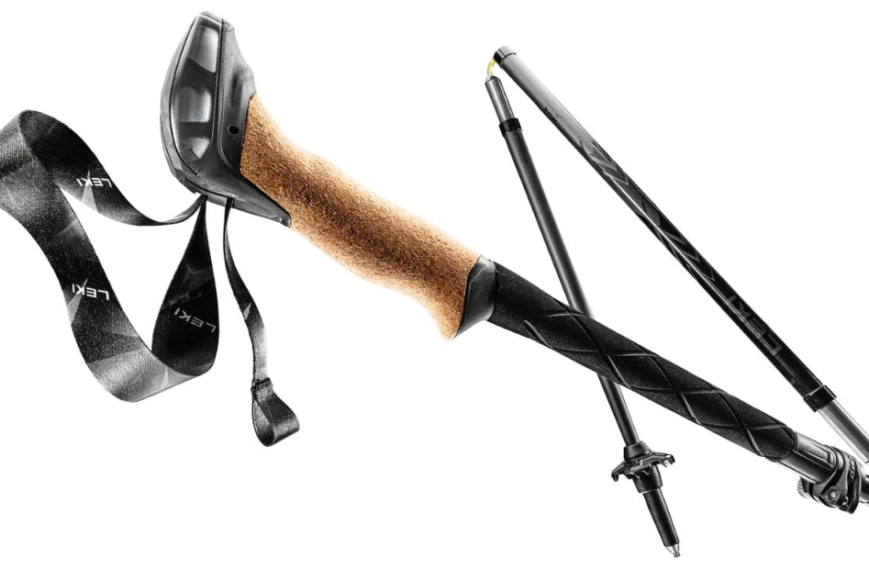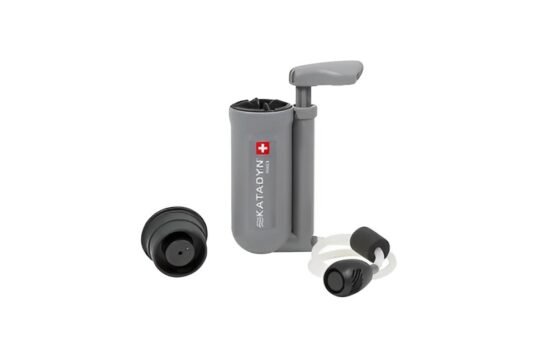- Lightweight waterproof hiking boots are essential for reducing fatigue, comfort, and foot health during hikes.
- Best women’s hiking boots should fit well, be durable, offer good traction, and manage moisture effectively.
- Men’s and women’s boots differ in fit and design due to different foot shapes and needs.
- Gore-Tex is a popular waterproof material in boots, offering breathability and protection.
- Advanced waterproofing technologies in boots improve comfort and longevity.
- For varying conditions, comfortable hiking shoes should offer breathability, insulation, a snug fit, and cushioning.
- Eco-friendly waterproof boots are available, using sustainable materials and methods.
- Grip and traction are crucial for slip-resistant boots, with sole design playing a key role.
- Long-distance hiking boots need durability, a snug fit, and support.
- Waterproof hiking footwear is versatile, and suitable for multiple outdoor activities.
- Maintain waterproof hiking boots by cleaning, drying, and applying waterproof treatments as needed.
- All-terrain hiking boots should be tough, have a high waterproof rating, and rugged outsoles for grip.
- Features of hiking boots differ by brand and model, with variations in technology and specific benefits offered.
Marching across wet trails and unpredictable terrain, a hiker’s best ally is often their boots. Are lightweight waterproof hiking boots essential gear? You bet they are! In every step, the right boots keep your feet dry and comfortable and support you for miles. Let’s lace up and dig into why cutting the weight without skimping on protection can level up your outdoor game. From conquering long distances to ensuring your foot health, discover the undeniable benefits that lightweight waterproof hiking boots bring to your adventures. Ready to trek smarter, not harder? Follow me.
Why Are Lightweight Waterproof Hiking Boots Essential for Outdoor Enthusiasts?
Why are hiking boots so heavy? They pack materials to tackle tough trails. But heavier boots can tire you out faster, especially on long hikes. This is where lightweight waterproof hiking boots shine.
Are lighter hiking boots better? Yes, for many hikers, lighter boots mean less fatigue and more comfort. When boots are light, your feet won’t feel as heavy. This can make a huge difference when you’re miles deep on a trail and have miles to go.
Why is it important to have lightweight hiking boots? Light boots can help you hike longer without tiring. They also mean less strain on your feet, ankles, and knees. This keeps you at ease and your feet in better shape.
Lightweight boots for long-distance hiking matter a lot. Hiking is not just about the distance. It’s also about the energy you spend. Less boot weight lets you use that energy to explore more. You get to enjoy the journey without sore feet.
The impact of boot weight on hiking and endurance is big. Less weight lets you move easier and quicker. You can cover more ground with less work. Your feet will thank you after a long day out in the wilds.
The benefits of a lighter boot on foot health and comfort are huge. You put less pressure on each step. This cuts down the risk of blisters and other foot pain. Like a good friend, your boots should help you, not hurt you, as you trek through nature.
So, as an outdoor lover, picking essential hiking footwear is key. Choose boots that keep you dry, light on your feet, and ready for the next hill. Happy trails await with your trusty lightweight boots!
What Features Define the Best Women’s Lightweight Waterproof Hiking Boots?
Good hiking boots keep feet dry and comfy on the trail. The best women’s lightweight waterproof hiking boots fuse several important traits to keep you moving. What qualities should you look for? Start with a snug fit tailored to women’s feet. A boot that fits will guard against blisters and provide the support you need.
Next, consider durability. Long-lasting boots save money and time. You want a pair that can take a beating on rocky paths. Look for tough materials that won’t give out when the trail gets tough.
Grip and traction are also key. Women’s hiking shoes with good traction can save you from slipping on wet rocks or muddy banks. This makes hikes safer and more fun. Seek out deep treads and soles that grab the ground.
Lastly, the boots must breathe while blocking water. This means your feet stay dry from outside wetness and don’t stew in sweat. This dual task – keeping water out and letting moisture escape – is central to comfort. When you’re miles into a hike, your feet will thank you for boots that manage moisture so well.
Overall, go for boots that offer a secure fit, can handle wear and tear, provide solid traction, and handle moisture like a champ. With these features, you’ll power through puddles and scale slopes, keeping your focus on the beauty around you, not the boots on your feet.
How Do Men’s and Women’s Lightweight Trail Boots Differ?
Men’s and women’s trail boots differ in design. Men’s hiking boots often have wider soles. Women’s boots tend to have narrower heels and higher arches. The weight of a lightweight hiking boot is usually less than two pounds.
Brands craft boots for men and women differently. They know that men and women have unique foot shapes and needs. Men’s feet are usually broader, especially at the toes and forefoot. Because of this, men’s lightweight trail boots often come with a roomier fit. This also impacts the way these boots support the foot, with the extra room being essential for comfort during long hikes.
In contrast, women’s feet tend to be smaller with a higher instep and arch. This means that gender-specific hiking boot design is not just about size. It’s about crafting a shoe that follows the contour of the foot. That’s why women’s boots often include more arch support. A good fit is absolutely vital for proper performance. If a boot fits well, it can help prevent injury and discomfort.
Both men and women need well-fitted shoes for hiking. If a boot doesn’t fit right, it can rub and lead to blisters or worse. Proper fit helps ensure you get the most from your boot. It can boost your balance, support your feet and ankles, and keep you going for miles.
Good boots make a difference for hikers of all genders. They support your feet and help you tackle the trails with ease. Whether you need men’s or women’s boots, the right pair with the right fit is out there waiting for your next adventure.
What Waterproof Materials are Key in Ultralight Backpacking Boots?
Which hiking boots are most waterproof? The most waterproof boots often have Gore-Tex linings. This material keeps feet dry even in heavy rain.
Waterproof materials for boots vary, but Gore-Tex is a top player. It’s a thin, strong layer that stops water from getting in. Air can still pass, so feet don’t sweat too much. Boots with Gore-Tex linings are great for keeping feet dry. But, this material can be warm in hot weather, and sometimes pricey.
Vegan waterproof hiking boots use different stuff. They avoid animal products like leather. They might use synthetics or plant-based materials. These boots can be waterproof too. But they may not last as long as leather or Gore-Tex boots.
Ultralight backpacking boots aim to protect without the bulk. Gone are the days of heavy, soaking boots that tire you out. Now, the focus is on materials that keep feet cozy, give support, and stop water. The key is in the blend of materials. A boot might have a waterproof, breathable membrane like Gore-Tex. It could also have a sturdy outer made of synthetic leather, nylon, or rubber.
These materials have been a game-changer. With them, hikers can trek further. They can explore more, without worrying about wet feet. It’s not magic, it’s science – and it’s at the heart of today’s best hiking gear.
How do Advanced Waterproofing Technologies Improve Hiking Boots?
Which hiking boots are most waterproof? Boots with advanced waterproofing technology rank highest. Modern waterproof tech keeps feet dry and comfy. Makers mix these into boots for tight, dry wear.
How do advanced technologies enhance boot waterproofing? They lock out water while letting air flow. This helps feet breathe and stops them from getting soaked. Innovative tech makes boots a shield against wet trails but still cool inside.
Boots today must use smart waterproofing to be top-notch. Makers like Gore-Tex lead with materials that beat water every time. They mix their tech into the boot fabric. For the long haul, this means dry feet on wet treks.
Hikers know boots must stay dry to last. Good care can keep the advanced tech working like new. After each hike, clean your boots well. Let them air out to stay fresh. This way, the waterproof magic keeps going. Remember, a boot that combats water adds joy to every trail you tackle.
What Makes for Comfortable Hiking Shoes in Varying Conditions?
What features contribute to a hiking shoe’s comfort in different weather conditions? The most important features are breathability, insulation, and cushioning.
When it’s hot, your feet sweat. You need breathable summer hiking boots for comfort. They let air in and keep your feet cool. Taking it up a notch, good ventilation is key. It stops blisters and keeps your feet dry.
In cold weather, your feet need to stay warm. Insulated waterproof hiking boots are a must here. They trap heat and block the cold. This way, your toes stay toasty all day long.
But that’s not all. The fit has to be right. Too tight and you get pain. Too loose and you might trip. The right fit will hug your foot just enough. And let’s not forget about soft cushioning. It helps absorb shocks when walking. It’s like each step lands on a soft pad.
In summary, we want comfy, snug shoes that handle all kinds of weather. From sunny trails to snowy paths, your feet should feel just right. Remember, the right shoes make your hike comfy, no matter the weather. So, aim for breathable shoes for heat, and insulated ones for cold. Plus, always check for a cushy sole and a snug fit. They’re your key to happy hiking.
Can Waterproof Outdoor Gear Include Eco-Friendly Hiking Boots?
Are there eco-friendly options for waterproof hiking boots? Yes, there are! Today’s outdoor gear includes boots that care for our planet. They use recycled materials and nature-friendly ways to keep your feet dry. Brands are now making eco-friendly waterproof boots, taking big steps towards greener paths.
Materials like organic cotton, recycled rubber, and even plants are in these boots. Makers skip the harmful chemicals to make them. This helps our earth. Plus, these materials still keep water out. When you pick boots, look for ones that say they’re made with care for nature.
The top brands offering eco-friendly waterproof hiking boots are keen on saving the environment. These brands mix smart design with eco-friendly practices. They prove that you don’t need to harm nature for top-notch gear. They offer durable, weatherproof boots that stand up to the wild.
But is there a catch? Sometimes. The trade-offs of eco-friendliness and durability can show in such boots. Eco-materials might not last as long as synthetic ones. Yet, many find that a small price for keeping our trails and forests clean and green. As an outdoor lover, supporting these innovations means you help our earth with every step.
Why is Grip and Traction Crucial for Slip-Resistant Trail Boots?
Are lighter hiking boots better? Yes, they help reduce fatigue. Lighter boots are better for hiking because they cause less strain on your legs and feet. This is especially true over long distances or when navigating through rough and tough terrain. But it’s not just about the weight. The design of the sole is vital for keeping you on your feet.
How does sole design affect slip resistance? The patterns on the soles, like deep lugs and specific rubber compounds, provide better grip. Soles with deep lugs can bite into the ground and mud, giving a secure feel underfoot. They work like tire treads, shedding mud and water to maintain contact with the trail. Rubber compounds formulated for grip keep you steady on wet rocks. They make all the difference when you are miles from home.
Boots for rough hiking trails must have grippy soles for slippery paths. Many popular brands balance weight and grip, offering slip-resistant trail boots that won’t weigh you down. For instance, in the slip-resistant category, various brands engineer their soles differently. Some use soft, sticky rubber for grip, while others develop complex lug patterns to channel water away and prevent mud build-up.
Compare the grip performance across popular boot brands by looking at user reviews and ratings. See how brands like Merrell, Salomon, and Keen stack up. Consider the type of hiking you do the most when choosing. If your hikes involve lots of wet and uneven paths, pay extra attention to the sole design and materials.
Remember, grip and traction can make or break your hiking experience. Choose wisely, and your boots will keep you moving forward safely.
How to Choose the Right Waterproof Hiking Boots for Long Distances?
What makes a hiking boot suitable for long distances? Durability, fit, and support.
As an outdoor enthusiast, I understand the need for the right gear. When it comes to long hikes, your boots make a big impact. You need a pair that stands up to miles of wear. Beware of blisters and sore feet that come from bad shoes.
When choosing waterproof hiking boots for long trails, consider a snug fit. Your heel should stay put when walking. The boots should give your toes room to move too. Make sure they’re built for distance. They should have a strong sole and enough cushion to ease your steps. The best lightweight waterproof hiking boots blend comfort, support, and weight. They help you go further with less effort.
Look for boots with proper arch support and ankle stability. They are key for carrying loads over miles. A wrong fit can turn an adventure sour fast.
A good boot review helps with this choice. Top-rated boots soar in fit, durability, and comfort. They gain the trust of hikers who test them on real trails. Long-distance waterproof boots have tough outsoles. They grip well on different grounds.
So for your next long trail, don’t just pick any boot. Choose one with the right build and fit. This will make a big difference in how you enjoy the hike. Trust me, your feet will thank you for it.
What Are the Diverse Uses for Waterproof Hiking Footwear?
What are the versatile applications for waterproof hiking footwear? They serve many outdoor activities. You can wear them not just for hiking but also for walking, fishing, or even working in wet conditions. They protect your feet in any place where you might face rain, mud, or puddles.
These boots are multi-use hiking boots. They are a key piece of outdoor adventure gear waterproof. They are boots suitable for hiking and walking over long distances. Plus, they keep your feet dry and comfy all day. Ever stepped in a stream and gotten your sock wet? Yeah, waterproof boots stop that.
Situations where waterproofing is crucial outside of hiking include camping trips, outdoor jobs, and any adventure where water may be an issue. You might be thinking, “But aren’t they heavy?” Not anymore. We’ve got lighter options that still do the job well. We want tough boots that can handle a day in the rain without feeling like bricks on our feet.
When picking these boots, make sure they won’t let you down in quality. They should last, fit right, and keep water out every step of the way. Trust me, having dry feet can make a big change in your outdoor fun. So yes, waterproofing is key for not just hikers, but for anyone who loves being outside.
How Can You Ensure Your Waterproof Hiking Boots Remain Effective?
To keep your waterproof hiking boots working well, clean and dry them often. This stops damage and keeps water out. The lacing system is key for a tight seal. So, use it right and check for wear. Boots can be fixed to last longer. Use patches or sealants for small holes or tears.
Parts of boots that often need care are the soles and seams. These spots can let water in if they wear out or split. When lacing your boots, make sure they fit snug but comfy. This helps the waterproof seal do its job well. Also, reapply waterproofing spray or wax when the boots start to absorb water instead of repel it.
If your boots begin to leak or the soles wear thin, look into repair options. Some boots are made to be fixed and not thrown away when damaged. You can have a cobbler replace the soles or fix the waterproof membrane. This can make your boots last much longer.
Remember these tips:
- Clean mud or dirt off right after each hike.
- Let boots dry naturally away from direct heat.
- Tighten laces for a good fit and seal.
- Treat with waterproofing products regularly.
- Check for repairs if leaks start.
Boots that get care stay dry inside and hold up to lots of hikes. They save you money and keep your feet happy on the trails!
What Should You Look For When Buying Hiking Boots Suitable for All Terrains?
What factors should be considered for all-terrain hiking boots? Look for a tough build, a solid waterproof rating, and rugged outsoles. These boots need to handle rocks, mud, and more. Good all-terrain waterproof footwear stands up to many kinds of ground. It keeps your feet dry too.
Let’s dive deeper. To take on all terrains, boots must be sturdy. Durable leather or synthetic materials make them last. They need a waterproof rating that you can trust. The higher the rating, the better. This keeps water out. It’s key for crossing streams or hiking in the rain. Have you seen terrain-gripping boot outsoles? They are a must. They can grip well on wet rocks and slippery mud.
Why does this matter? Terrain can change fast when you are out hiking. One minute you’re on a dry, dusty path. The next, you’re stepping through a puddle or climbing a rocky hill. Good boots keep you moving. They keep you sure-footed. They protect your feet. They can make your hike a fun day out, not a tough slog.
Remember, when you pick boots, think grip, water protection, and toughness. That way, you’re ready for any adventure thrown your way!
How Do Waterproof Hiking Boot Features Differ Across Brands and Models?
When asked how features vary by brand, I say, each label has its magic touch. Salomon hiking boots, for instance, often have a sleek design and aggressive tread for grip. Other brands might focus on ultra-light materials or special cushioning for comfort.
A direct comparison of lightweight hiking boots reveals a mix of traits. Some brands may favor support and durability, while others prioritize weight reduction and flexibility. It’s common to find boots boasting waterproof membranes like Gore-Tex for dryness without added bulk.
Top-rated waterproof boots have earned their status by balancing key features. These include waterproofing, weight, durability, and comfort. Reliable traction is a constant among the best. Each offers distinct benefits and sometimes, unique technology aimed at outdoor buffs.
When you look at various boots, you often see their standout features first. Like, some might have a unique lacing system that promotes a snug fit. Others might be made of eco-friendly materials, appealing to the green-hearted hiker. Brands like Salomon are known for integrating advanced features into their boots. They craft designs that provide stability, protect, and maintain comfort across many terrains.
I dig deep into reviews and ratings to grasp what makes each boot shine. This doesn’t just show what’s popular but also indicates which features stand out across different environments and usage scenarios. I lean heavily on detailed reviews that get into the nitty-gritty. These often reveal how well boots hold up under pressure and what unique elements each pair brings to your trek.
In a nutshell, waterproof hiking boot features are numerous and varied across brands. Understanding the nuances of each can be crucial for finding the perfect pair. It’s all about matching your hiking style and needs with the specialized features of renowned brands.
Conclusion
To wrap up, choosing the right lightweight waterproof hiking boots matters. We’ve seen how they keep your feet dry, support long treks, and give you a good grip. Good boots bring comfort and support on all trails. They vary in design, fit, and technology, but the goal is the same: protect your feet and boost your hiking game. Remember, the best pair suits your feet and your adventure. Get boots that last, feel great, and handle any path. Happy hiking!
![]()

